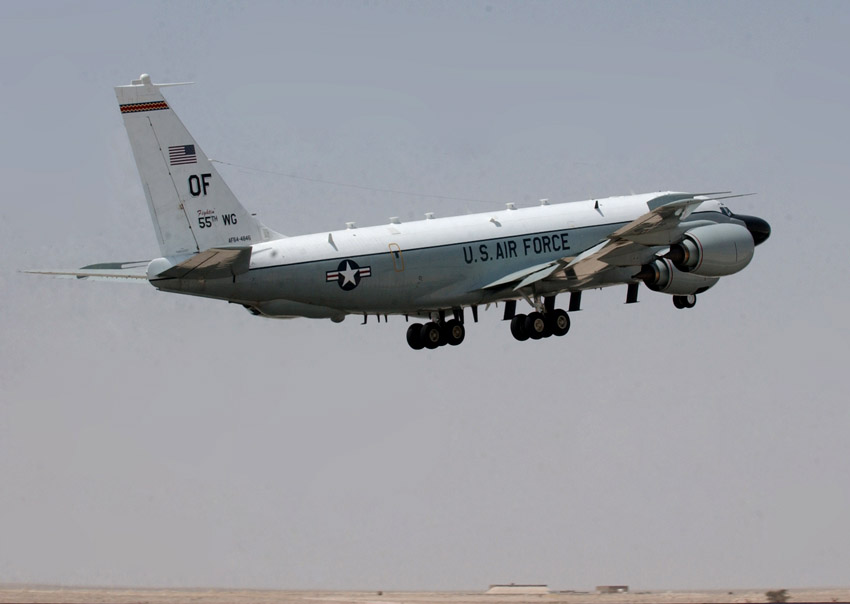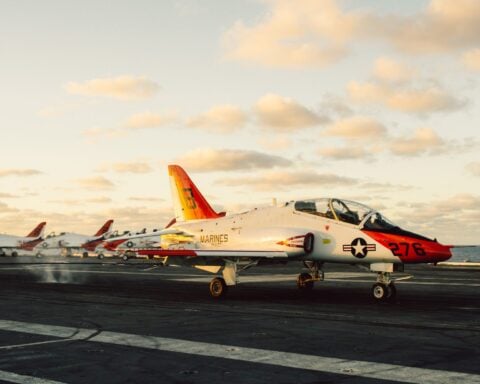
This post has been updated to include additional information from the Department of Defense.
Two Chinese military aircraft intercepted an U.S. Air Force surveillance plane in a Sept. 15 incident in a potentially “unsafe” manner, a Pentagon official told USNI News.
“The department is reviewing a report from U.S. [Pacific Command] regarding a Sept. 15 intercept of a U.S. RC-135 by two JH-7 aircraft from the People’s Republic of China,” Pentagon spokesman Cmdr. Bill Urban told USNI News on Tuesday.
“One of the maneuvers conducted by a PRC aircraft during the intercept was perceived as unsafe by the RC-135 aircrew. At this point there is no indication that there was a ‘near collision’.”
USNI News understands one of the Xian JH-7 Flounder fighters crossed about 500 feet in front of the nose of a U.S. Air Force RC-135 Rivet Joint surveillance aircraft.
The Pentagon made clear it wasn’t admonishing China for the intercept yet.
“No final characterization of the intercept has been determined at this time. The department is reviewing U.S. PACOM’s report and will take appropriate action,” Urban said.
“Over the past year, we have seen improvements in PRC behavior, specifically the safety and professionalism with which they intercept our aircraft. Further, DoD has robust, existing mechanisms to deal with incidents between our operating forces.”
In an earlier Tuesday press conference, Pentagon spokesman Peter Cook said “there’s no indication this was a near collision but the report that came back was that the plane operated in an unsafe fashion.”
The incident, which occurred in the Yellow Sea between the Chinese Shandong and Korean peninsula, was first reported on Tuesday in a story in the Free Beacon.
The Defense Department’s comments on the intercept contrast sharply from an incident in 2014 where a Chinese People’s Liberation Army Air Force (PLAAF) J-11 fighter buzzed a Boeing P-8A Poseidon maritime surveillance aircraft.
Then Defense Department spokesman Rear Adm. John Kirby issued a condemnation of the “unprofessional” pass.
“We have registered our strong concerns to the Chinese about the unsafe and unprofessional intercept, which posed a risk to the safety and the well-being of the aircrew, and was inconsistent with customary international law,” Kirby said at the time.
“The Chinese jet also passed the nose of the P-8 at 90 degrees with its belly toward the P-8 Poseidon, we believe to make a point of showing its weapons load-out.”
Cook said from his understanding the Sept. 15 intercept “was not similar” to the 2014 P-8A incident.

Senate Armed Services Committee (SASC) chairman Sen. John McCain (R-Ariz.) issued a Tuesday afternoon statement condemning the Chinese action as messaging ahead of the planned visit of Chinese President Xi Jinping to the U.S.
“Yet another dangerous Chinese intercept of a U.S. aircraft last week shows that China feels emboldened to continue its pattern of aggressive behavior in the Asia-Pacific region,” read the statement.
“That this flight came amid negotiations of rules for air-to-air encounters and just one week ahead of President Xi’s arrival in the United States raises further questions about China’s intentions and the Obama Administration’s response thus far.”
While Chinese intercepts of U.S. aircraft over the South China and East China seas are not uncommon, incidents like the one on Sept. 15 are rare.
The following is a partial transcript of Peter Cook’s comments in a Sept. 22, 2015 press briefing on the Sept. 15 RC-135 intercept.
The Department is reviewing a report that came in from PACOM regarding a Sept. 15 intercept of an RC-135 by an aircraft from the People’s Republic of China. The incident in question happened in the Yellow Sea approximately 80 miles east of of the Shandong peninsula. One of the maneuvers conducted by the Chinese aircraft during the incident was perceived as unsafe by the RC-135 aircrew and at this point, right now, there’s no indication this was a near collision but the report that came back was that the plane operated in an unsafe fashion.
There’s been no further determination at this time — it’s still under review.





